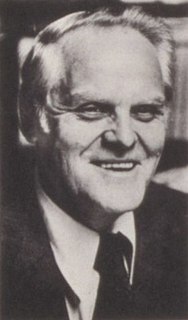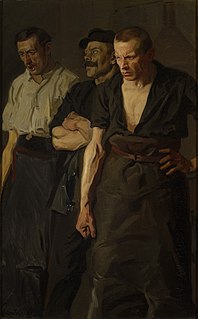Related Research Articles

Gus Hall was the General Secretary of the Communist Party USA (CPUSA) and its four-time U.S. presidential candidate. As a labor leader, Hall was closely associated with the so-called "Little Steel" Strike of 1937, an effort to unionize the nation's smaller, regional steel manufacturers. During the Second Red Scare, Hall was indicted under the Smith Act and was sentenced to eight years in prison. After his release, Hall led the CPUSA for over 40 years, often taking an orthodox Marxist–Leninist stance.
The Communist Party USA and its allies played an important role in the United States labor movement, particularly in the 1930s and 1940s, but never succeeded, with rare exceptions, either in bringing the labor movement around to its agenda of fighting for socialism and full workers' control over industry, or in converting their influence in any particular union into membership gains for the Party. The CP has had only negligible influence in labor since its supporters' defeat in internal union political battles in the aftermath of World War II and the CIO's expulsion of the unions in which they held the most influence in 1950. After the expulsion of the Communists, organized labor in the United States began a steady decline.

Philip Murray was a Scottish-born steelworker and an American labor leader. He was the first president of the Steel Workers Organizing Committee (SWOC), the first president of the United Steelworkers of America (USWA), and the longest-serving president of the Congress of Industrial Organizations (CIO).

The Minneapolis general strike of 1934 grew out of a strike by Teamsters against most of the trucking companies operating in Minneapolis, the major distribution center for the Upper Midwest. The strike began on May 16, 1934 in the Market District. The worst single day was Friday, July 20, called "Bloody Friday", when police shot at strikers in a downtown truck battle, killing two and injuring 67. Ensuing violence lasted periodically throughout the summer. The strike was formally ended on August 22.

In the Memorial Day massacre of 1937, the Chicago Police Department shot and killed ten unarmed demonstrators in Chicago, on May 30, 1937. The incident took place during the Little Steel strike in the United States.

Republic Steel is an American steel manufacturer that was once the country's third largest steel producer. It was founded as the Republic Iron and Steel Company in Youngstown, Ohio in 1899. After rising to prominence during the early 20th Century, Republic suffered heavy economic losses and was eventually bought out before re-emerging in the early 2000s as a subsidiary. The company currently manufactures Special Bar Quality (SBQ) steel bars and employs around 2,000 people. It is currently owned by Grupo Simec, based in Guadalajara, Mexico.
Timeline of trade union history

The Youngstown Iron Sheet and Tube Company, based in Youngstown, Ohio, was an American steel manufacturer. Officially, the company was created on November 23, 1900, when Articles of Incorporation of the Youngstown Iron Sheet and Tube Company were filed with the Ohio Secretary of State at Columbus. It acquired the Mark Manufacturing Company in 1923. Youngstown Sheet and Tube remained in business until 1977. A Youngstown resident acquired the name, trademark, and logo in 2014 and opened a small business promoting the economic redevelopment of Youngstown.

The Steel Strike of 1919 was an attempt by the weakened Amalgamated Association of Iron, Steel and Tin Workers (AA) to organize the United States steel industry in the wake of World War I. The strike began on September 22, 1919, and collapsed on January 8, 1920.
The Steel Workers Organizing Committee (SWOC) was one of two precursor labor organizations to the United Steelworkers. It was formed by the CIO on June 7, 1936. It disbanded in 1942 to become the United Steel Workers of America. The Steel Labor was the official paper of SWOC.

Amalgamated Association of Iron and Steel Workers (AA) was an American labor union formed in 1876 to represent iron and steel workers. It partnered with the Steel Workers Organizing Committee of the CIO, in November 1935. Both organizations disbanded May 22, 1942, to form a new organization, the United Steelworkers.
The Toledo Auto-Lite strike was a strike by a federal labor union of the American Federation of Labor (AFL) against the Electric Auto-Lite company of Toledo, Ohio, from April 12 to June 3, 1934.
The Remington Rand strike of 1936–1937 was a strike by a federal union affiliated with the American Federation of Labor (AFL) against the Remington Rand company. The strike began in May 1936 and ended in April 1937, although the strike settlement would not be fully implemented until mid-1940.
In re Labor Board, 304 U.S. 486 (1938), is a 5-to-2 decision by the Supreme Court of the United States which held that the National Labor Relations Act requires the filing of a petition and a transcript in order for an enforcement order to proceed in federal court, and that a writ of prohibition and writ of mandamus are appropriate measures to take in quashing a petition when no transcript has been filed.

Anti-union violence is physical force intended to harm union officials, union organizers, union members, union sympathizers, or their families. It is most commonly used either during union organizing efforts, or during strikes. The aim most often is to prevent a union from forming, to destroy an existing union, or to reduce the effectiveness of a union or a particular strike action. If strikers prevent people or goods to enter or leave a workplace, violence may be used to allow people and goods to pass the picket line.

Benjamin Franklin Fairless was an American steel company executive. He was president of a wide range of steel companies during a turbulent and formative period in the American steel industry. His roles included President of Central Alloy Steel from 1928 to 1930; First Vice President of Republic Steel from 1930 to 1935; President of the Carnegie-Illinois Steel Company from 1935 to 1938; and then President (1938–1955), and later Chief Executive Officer and Chairman of the board of directors (1952–1955) of U.S. Steel, the largest steel corporation in the United States.

The Little Steel strike was a 1937 labor strike by the Congress of Industrial Organizations (CIO) and its branch the Steel Workers Organizing Committee (SWOC), against a number of smaller steel producing companies, principally Republic Steel, Inland Steel, and Youngstown Sheet and Tube Company. The strike affected a total of thirty different mills belonging to the three companies, which employed 80,000 workers. The strike, which was one of the most violent labor disputes of the 1930s, ended without the strikers achieving their principal goal, recognition by the companies of the union as the bargaining agent for the workers.

The Congress of Industrial Organizations (CIO) was a federation of unions that organized workers in industrial unions in the United States and Canada from 1935 to 1955. Originally created in 1935 as a committee within the American Federation of Labor (AFL) by John L. Lewis, a member of the United Mine Workers (UMW), and called the Committee for Industrial Organization, its name was changed in 1938 when it broke away from the American Federation of Labor. It also changed names because it was not successful with organizing unskilled workers within the AFL.

Anti-union violence in the United States is physical force intended to harm union officials, union organizers, union members, union sympathizers, or their families. It has most commonly been used either during union organizing efforts, or during strikes. The aim most often is to prevent a union from forming, to destroy an existing union, or to reduce the effectiveness of a union or a particular strike action. If strikers prevent people or goods to enter or leave a workplace, violence may be used to allow people and goods to pass the picket line.
Jesse Reese, was a black communist and militant trade unionist in the United States.
References
- 1 2 3 4 Smith, Rick. "The Women's Day Massacre." Daily Kos. The Rick Smith Show, 19 June 2015. Web. 8 Oct. 2015. http://www.dailykos.com/story/2015/06/19/1394158/-The-Woman-s-Day-Massacre
- 1 2 3 4 Wojcik, John. "Today in Labor History: The 1937 'Women's Day Massacre'" People's World. N.p., 19 June 2013. Web. 8 Oct. 2015. http://peoplesworld.org/today-in-labor-history-the-1937-women-s-day-massacre/
- 1 2 3 4 Blake, Benjamin. "The Women's Day Massacre." Csu Ohio. Western Reserve Historical Society, N.d. Web. 8 Oct. 2015. http://academic.csuohio.edu/clevelandhistory/Issue3/articles/steelpage6content.htm